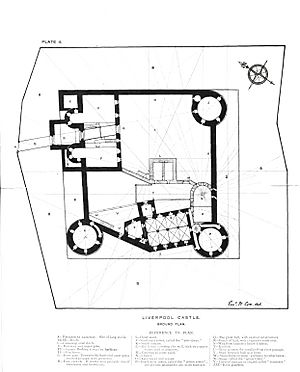Liverpool Castle facts for kids
Quick facts for kids Liverpool Castle |
|
|---|---|

Plaque on Victoria Monument
|
|
| General information | |
| Architectural style | Fortified manor house |
| Town or city | Liverpool, Merseyside |
| Country | England |
| Coordinates | 53°24′18″N 2°59′20″W / 53.404934°N 2.988891°W |
| Construction started | 1232 |
| Completed | 1237 |
| Demolished | 1726 |
| Client | William de Ferrers, 4th Earl of Derby |
Liverpool Castle was an important castle located in Liverpool, England. It stood for about 500 years, from the early 1200s until the early 1700s (1237-1726). It was a strong building that played a role in the city's early history.
Contents
Building Liverpool Castle
The castle was likely built between 1232 and 1235. William de Ferrers, 4th Earl of Derby ordered its construction. He received special permission to build a fortified structure in 1235.
Liverpool Castle was built to protect a new port created by King John. It was placed on the highest point in the city. This spot overlooked a natural inlet called "the Pool." Today, this area is known as Derby Square, where the Queen Victoria Monument stands.
What the Castle Looked Like
Liverpool Castle was built on a specially made raised area. A wide moat (a deep ditch filled with water) was dug around it. This moat was about 18 meters (20 yards) wide and carved out of solid rock.
The main part of the castle had a gatehouse. This gatehouse was protected by two towers at the front. There were also three round towers at the other corners. A fourth tower was added later in 1442. Strong walls connected these four towers. Inside the castle walls, there was a large hall and a chapel. There was also a place for making beer (brewhouse) and baking bread (bakehouse). A secret passage ran from under the moat towards the river. Outside the castle walls, there was a dovecot (a building for doves) and an orchard.
The Castle's Story
After William de Ferrers died in 1247, his son, William de Ferrers, 5th Earl of Derby, took over the castle. Later, the castle was taken by the King. King Henry III gave the land to his son, Edmund.
The castle then passed to Edmund's son, Thomas. In 1315, Thomas gave the castle to Robert de Holland. This decision made some other landowners unhappy. On October 25, 1315, a group of them attacked the castle. This event was part of something called the Banastre Rebellion. The attackers were defeated quickly, within an hour. This was the only recorded attack on the castle before the English Civil War.
Between 1315 and 1323, the castle returned to the King's control. In 1323, King Edward II visited Liverpool and stayed at the castle. Later, King Edward III used Liverpool as a port for his wars. In 1327, he ordered the castle's leader to give shelter to people escaping from the Scots. Records from 1367 show the castle had a moat and a dovecot.
In 1440, Sir Richard Molyneux became the castle's leader. This role became a family tradition. In 1442, the castle was made stronger. A fourth tower was added to the south-east corner. By 1559, the castle was described as "in utter ruin and decay." Repairs were planned to prevent it from completely falling apart.
During the reign of Charles I, the castle was involved in the English Civil War. In 1644, Prince Rupert and his soldiers captured it. Later, Sir John Moore took it back. In 1689, supporters of William of Orange seized the castle.
In 1704, the people of Liverpool got a lease for the castle site. However, there was a disagreement over who truly owned it. This delayed things until 1726. That year, the last parts of the castle were finally removed. Some of its stone might have been used to build a new dock. In 1715, a law was passed to demolish the castle and build a church there. St George's Church was built on the site and finished in 1734. Later, this church was also pulled down. In 1899, the church was demolished again, and the Victoria Monument was built there in 1902. Today, the Crown Courts building stands nearby, designed to look a bit like a castle.
A Castle Replica
In Lever Park, Rivington, near Chorley, there's a smaller version of Liverpool Castle. William Lever built this "folly" (a building made just for decoration) starting in 1912. It's a scale replica of the castle, made to look like ruins. The design was based on old records and drawings from 1892.
Images for kids




